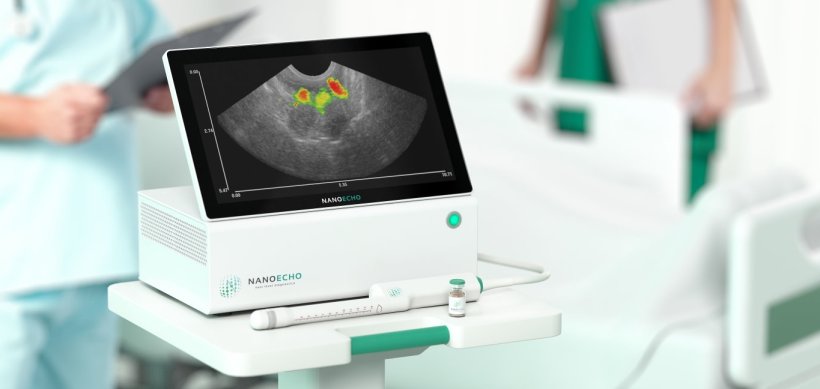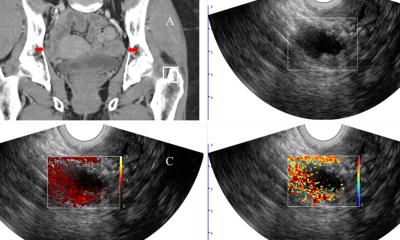
© NanoEcho
Article • New system combines nanotechnology and ultrasound
Reducing over-treatment of rectal cancer
An innovative solution based on nanotechnology and ultrasound could prevent over-treatment of patients with rectal cancer. The magnetomotive ultrasound system uses nanotechnology for reliable diagnosis of any spread of rectal cancer to nearby lymph nodes.
Report: Mark Nicholls
The system is designed to address indications of unnecessary surgery, caused by the current lack of a definitive method to identify this spread. With high resolution imagery harnessed to offer a better assessment of rectal cancer in patients, iron oxide-based nanoparticles injected locally around the tumour are utilized as a contrast agent to enable a probe to differentiate between healthy and unhealthy tissue in the rectum.

At the Medica trade fair in Dusseldorf, Kristina Hallström outlined the benefits of the system developed by NanoEcho, a Swedish company founded by a research group at the Department of Biomedical Engineering at Lund University. In her presentation, the NanoEcho marketing director highlighted how the company has developed the diagnostic rectal cancer technology.
The focus is specifically on rectal cancer, which makes up a third of the colorectal cancer group – the second most common type of cancer after breast cancer for women and prostate cancer for men. Hallström said: ‘Every year, 600,000 people are diagnosed with rectal cancer globally, with that expected to increase due to ageing populations and western lifestyle. ‘Early detection and reliable diagnostics are crucial. In rectal cancer, it is important to identify whether there is a spread of cancer cells to the nearby lymph nodes, especially in the early stages.’
However, she pointed to research suggesting that many patients suffering rectal cancer are overtreated. ‘To ensure all cancer cells are removed, most patients diagnosed with early rectal cancer undergo a major surgical procedure, resulting in permanent stomia,’ continued Hallström. ‘But research has shown that this was unnecessary in nine cases out of 10, because in those cases there was no cancer spread to nearby lymph nodes and a minor intervention would have sufficed.’
Rotating magnet makes particles move
NanoEcho’s solution aims to reduce this unnecessary overtreatment by differentiating between healthy and diseased tissue. The injected iron oxide-based nanoparticles it uses are super-lymphatic, are the right size to go into the lymph system, and are spread differently depending on whether the tissue is healthy or unhealthy.
When a probe with an integrated rotating magnet is inserted into the rectum, applying a magnetic field, the nanoparticles start to move. Hallström said: ‘Ultrasound is used to visualise the movement of the nanoparticles on the screen in real time. The amount of accumulated nanoparticles enables differentiation between healthy and diseased tissue.’

© NanoEcho
Better diagnostics, she continued, mean the patient can receive an individually adapted, effective, and less risky treatment. ‘It is especially important for patients with stage 1 or 2 rectal cancer, and this is a group that will increase due to on-going implementation of screening.’
The aim is to avoid patients undergoing major surgery and the risk of incontinence, as well as freeing up healthcare resources. ‘NanoEcho addresses a growing unmet medical need to provide correct diagnosis of rectal cancer spread to nearby lymph nodes,’ added Hallström. ‘This ensures rectal cancer patients receive a correct diagnosis and an optimal individualized treatment, which would free-up resources, reduce costs for society and increase quality of life for the patients.’
The system developed by NanoEcho and its partners includes advanced software, an ultrasound device with an integrated magnet, with the nanoparticle developed by an external company. While the focus is on rectal cancer diagnostics, the company believes the technology has other potential applications such as the detection of prostate cancer, the identification of plaques in blood vessels or as a tool for stem cell therapies.
The system is now under the verification and validation process with further clinical assessment scheduled for 2024 and an aim to place the product on the market in 2026.
Profile:
Kristina Hallström leads the marketing and communication efforts along with quality and regulatory affairs at NanoEcho. An experienced professional at the intersection between healthcare and business with a Master of Business Administration from Lund University and a background as a physiotherapist, she combined a focus on both clinical aspects and business development. Her career spans large international MedTech companies, as well as start-up companies with innovative products.
28.02.2024











